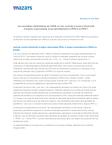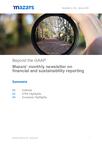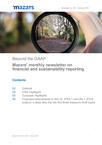
New IASB clarifications on renewable power purchase agreements and amendments to IFRS 9 and IFRS 7
Bucharest, 1 April 2024
Renewable Power Purchase Agreements (PPA)
In December 2023, IASB confirmed the launch of draft amendments to IFRS 9 - Financial Instruments to clarify the accounting treatment of renewable power purchase agreements (known as "PPA").
This decision follows the investigations conducted by the IASB team in July 2023, the results of which were presented to the Board in December 2023. This research confirmed the increasing importance of contracts known as PPA in many jurisdictions and the existence of a diversity of practices in the application of IFRS 9 to these types of contracts.
These investigations have also helped shape the direction of future amendments. These could be directed, firstly, towards the exclusion from the scope of IFRS 9 of contracts for the purchase/sale of non-financial items for own use (known as 'own property') and, secondly, towards hedge accounting applied in the specific context of PPA contracts.
Concerning the exclusion known as 'proprietary ownership', the amendments could involve the introduction of application guidance to clarify how to assess the entity's anticipated use of a contract when the non-financial item purchased has characteristics specific to the electricity market. These characteristics include a lack of control over the frequency and volume produced or delivered, a relatively high level of certainty about the use or sale of the energy delivered, and the provision by the electricity market for any unused volume to be returned to the grid at the prevailing market price. These clarifications could thus allow several physical power purchase agreements ("physical PPA") to be classified as "proprietary".
Regarding hedge accounting, the amendments could involve adding provisions to allow the assessment of the highly probable nature of future transactions when the non-financial item purchased has the specific characteristics of the electricity market described above. These clarifications could thus allow the designation of virtual power purchase agreements ("VPPAs" or "virtual PPAs") as hedging instruments in a future cash flow hedging relationship.
The next step in this project is to publish an exposure draft for consultation, which is expected to take place in the second quarter of 2024.
IASB reviews of the draft amendments to IFRS 9 and IFRS 7
After the first reconsiderations in November 2023, IASB continued in January and February, the review of comment letters received on the exposure draft for consultation on amendments to IFRS 9 and IFRS 7, which relate to the classification and measurement of financial instruments.
Temporarily, the Board has decided to conclude the proposed amendments, contingent upon the requirement outlined in paragraph B4.1.20A of the exposure draft, stipulating that the subordinated debt instrument must remain under the ownership of the sponsor (the transferring entity) throughout the transaction. Additionally, minor revisions will be made to the drafting of the proposed amendments. Staff documents specifically recommend:
- for non-recourse assets, the deletion of the non-recourse criterion "throughout the life of the financial asset" in paragraph B4.1.16A of the exposure draft, and the retention only of that applicable in the event of default by the debtor;
- for CLI assets, clarification in paragraph B4.1.23 of the exposure draft for consultation of the existence of a rebuttable presumption of SPPI qualification when an underlying pool of assets includes lease receivables.
IASB has considered proposed amendments to IFRS 7 that require additional disclosures about loans whose contractual cash flows may change if contingent events occur (paragraphs 20B and 20C of the exposure draft). Temporarily, the Board decided to:
- keep both financial liabilities and financial assets within scope;
- limit the scope of paragraph 20B of the exposure draft to consultation to contractual terms that could change the amount of cash flows related to a contingent event that is not directly related to the costs and risks of an underlying debt instrument. Thus, this area excludes clauses related to time value and credit risk, such as late interest or early repayment clauses in case of covenant breaches, but includes clauses such as i) indexing the interest rate of a loan on a borrower-specific ESG criterion, ii) indexing the interest rate of a debt to the achievement of a volume of activity by the lender (as is found for ECB loan rates known as "TLTRO").
- relax the quantitative disclosure requirement to allow an entity to disclose, if relevant, information other than the range of variability of future cash flows;
- set the date of entry into force of the amendments for financial years starting on 1 January 2026; this decision was adopted by a small majority;
- finalise the transitional provisions proposed in the exposure draft; and allow early adoption of the amendments to the SPPI criterion and IFRS 7 disclosure requirements relating to changes in contractual cash flows without the need to apply the other amendments early from the same date.
Temporarily, the Board decided not to re-expose the text of the exposure draft to the consultation and to prepare for the publication of the final version of the amendment.
Initial IASB Reassessments of the Post-implementation Review of IFRS 9, Phase 2 - Impairment
In February, IASB began its consideration of comments received in response to its request for information on the post-implementation review of IFRS 9, Phase 2 - Impairment.
Without disputing the general approach, commentators in particular called on the IASB to reassess the application of this approach:
- to loans and guarantees within the group;
- on loans that are impaired since acquisition (POCI).
In response, the Board decided not to adopt additional regulatory measures because it believes that the problems mentioned can be resolved within the current framework of the rule and because it does not wish to deviate from a principles-based approach or question practices already in place. However, the staff intends to seek the views of the Interpretations Committee (IFRS-IC) at its March meeting to consider the implementation difficulties raised, in particular concerning intra-group loans and guarantees.
On the subject of determining significant increases in credit risk, commentators have pointed IASB to:
- diversity of practices in determining significant increases in credit risk (SICR);
- limited application of collective assessment in the assessment of SCIR.
In response, the Board decided not to adopt additional regulatory measures, for the same reasons as mentioned above for the general approach.
In future meetings, IASB will consider the comments received on the measurement of provisions and post-balance sheet adjustments, interactions with other standards, and disclosures in appendices.
To discover more, access the newsletters and documents available below.




